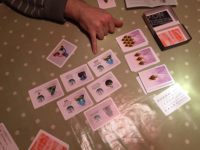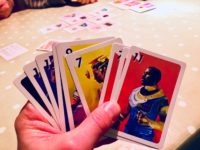- Learning time
- 30 minutes
- First play time
- 45 minutes
Rebel Nox
Designed by: Anna Wermlund,Eilif Svensson,Helge Meissner,Kristian Amundsen Østby
Rebel Nox is a trick-taking game where players may win as individuals, or as a team.
The cards consist of three suits (blue, red, yellow) plus three Rebel cards, one of which is the Commander. The Rebel cards are shuffled into the deck before dealing, and anyone receiving a Rebel card announces themselves as a Rebel – everyone else is on the Loyalist team. The Commander leads the first trick, with the catch that (on every trick) whatever colour suit is led, another suit will automatically be the strongest suit, the trump: if red is led, trumps are yellow, if yellow is led trumps are blue, and if blue is led, then it’s red.
The contesting of each trick is similar to many other trick-taking games such as whist or Wizard: players must follow suit of the led card if they can; if they can’t they may either dump an unwanted card or (assuming trumps weren’t led) play a trump card to win the trick themselves. Like most trick-takers, the most powerful card wins the trick.
But around that familiar structure there’s quite a lot of other stuff going on. Firstly a closer look at the cards reveals some symbols: flags represent points that will be claimed by the winner of the trick. Guns represent assassins and will kill off the highest card (or cards!) before the winner of the trick is decided. And vials played by any card mean the winner of the trick will give some cards (chosen randomly) to the player who played the lowest-value card. The recipient must then give cards from their own hand to the winner – but not any of the ones they just stole. The Rebel cards are still floating around in hands – they cannot be played, but they can be passed in these instance. So the passing of cards can change the make-up of a team, with a Rebel deserting the Rebels for the status quo, and a Loyalist suddenly finding themselves demoted to Rebel!
Secondly, each trick is contesting a location card on the table, and depending on whether you’re a Rebel or not, or what other locations you have already won, you may not want to win the trick. This is part of a larger goal for the Rebels and non-Rebels: at the end of the round individuals will score points for flags and locations, but the team with the most points will get bonuses – giving Rebel Nox a slippery, duplicitous feel as people regularly change sides – sometimes without really wanting to!
Joe says
This felt completely bemusing to me - a shame as I really enjoy Capital Lux.
The guru's verdict
-
Take That!
Take That!
More than in a standard trick-taking game: cards are shot down or stolen, players change teams against their will, and it feels like fighting fate as much as your opponents.
-
Fidget Factor!
Fidget Factor!
Every trick takes a bit of working out - some more than others - regarding what happens, especially if several icons are on display meaning assassination and card-swapping. Decisions are not straightforward either.
-
Brain Burn!
Brain Burn!
Although the rules aren't tremendously heavy, there are a lot of moving pieces here - some known, some unknown. You may count on a team-mate winning a trick only to discover they've changed sides...
-
Again Again!
Again Again!
If it's tricky to get your head around, at least you can't say Rebel Nox gets played-out quickly.








Sam says
Set in the same world (and strikingly so by the same illustrator) as Capital Lux, this is another card game of political chicanery. But whereas Capital Lux had enough intrigue to be fun without overwhelming, a first play of Rebel Nox is an exercise in plate-spinning: where at least one of the plates is invisible! Further plays would no doubt be more illuminating, but a first jaunt into Rebel Nox felt fairly chaotic with at least some of the decision-making being forced by circumstance rather than any grand strategy. That opacity and lack of control doesn't feel fun on a first play; but nonetheless Rebel Nox was an intriguing, unique experience that I'd be interested in trying again.